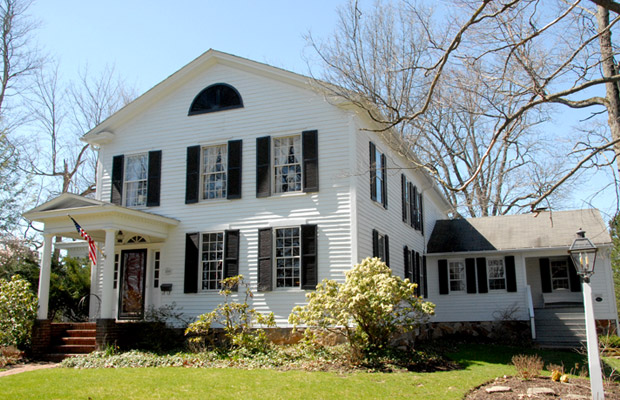NEXT MEETING: Thurs, Sept 11, 7:00pm at Barlow Community Center. Archivist Gwendolyn Mayer on The Science, Art and Slugs of Hudson, Ohio’s Alfred Pettingell.
Harvey Coe House

The Harvey Coe House is a gracious blend of Federal and Greek Revival elements. It consists of two houses that were joined together, with the older one (pre-1835) in the rear. The roof on the older section was raised so that the entire structure shares a single roofline. On his architectural inspection, Charles Willits noted that this single roofline is unusual anywhere and unique in early Hudson homes.
There are hand-hewn wood pegged beams in the attic. Some vertical supports are whole logs with bark. There is also original flooring in the attic.
Early chimneys were removed in the 1920s, and the current chimney has been re-bricked. There are original mantels in the living room and dining room that reflect the design in Country Builder’s Assistant, plate 17. The fanlight was rebuilt in 1973.
Other woodwork details are of note, too, including a newel post on the front stairway, pegged through to the basement, based on American Builder’s Companion by Asher Benjamin. (plate 43)
Reverend Coe built and occupied the house from 1835-1855 with his wife Deborah and their six daughters. Papers and boxes found in the walls were addressed to Coe and date from 1835.
Rev. Coe was the first elected trustee of Western Reserve College. He came to Hudson and lived in the south half of the President’s House from 1830-1834. He served on the board of trustees from 1826-1855, and was secretary from 1832-1840.
Western Reserve College was the only college that came out publicly for abolition in 1833. Coe was part of the colonization versus emancipation arguments that threatened to split Hudson in the 1830s. Coe was on the side of colonization (as was David Hudson).
By 1848, matters had become so heated that Coe was asked to resign. He refused, and, as there was no method for removal, he was allowed to stay. When President Hitchcock took over WRC, however, Coe and four others left.
Coe died in 1860, his wife in 1864.